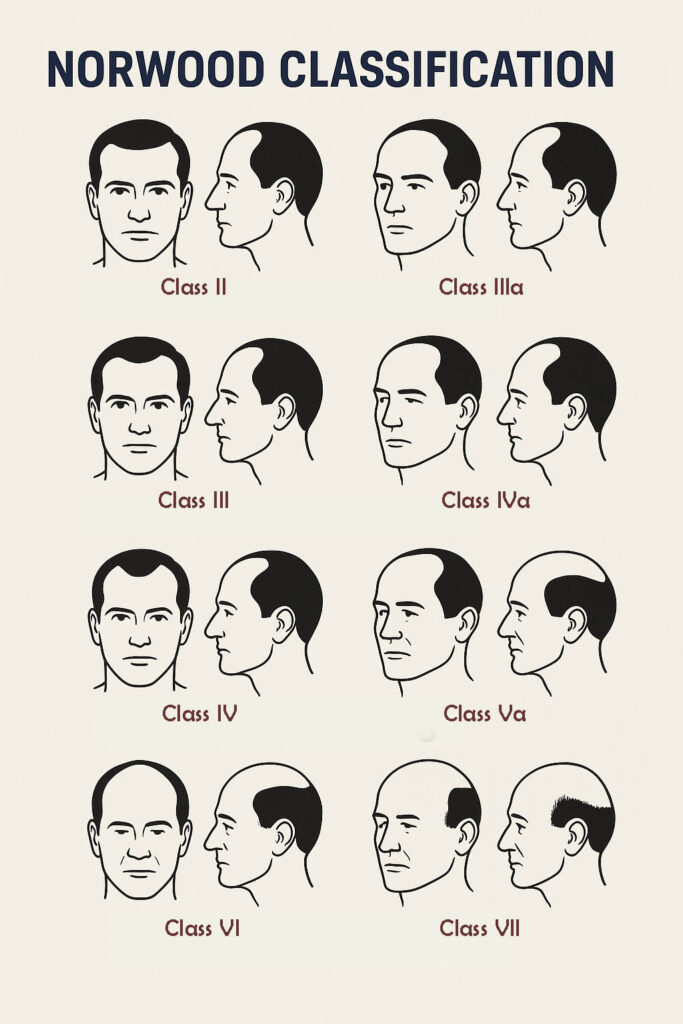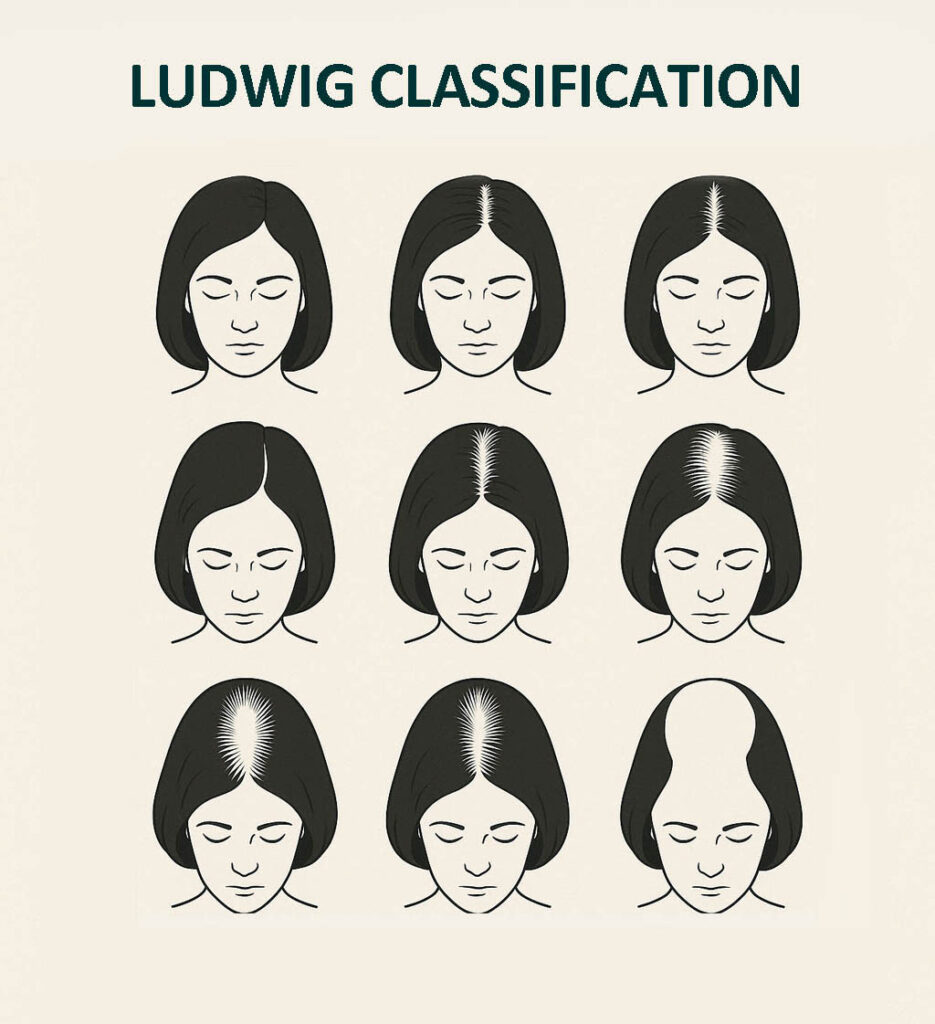- Hotline: 852+ 2891 9689
- Whatsapp: 852+ 9146 8426
- [email protected]
- 6/F 29 Austin Road, Tsimshatsui, Kowloon, Hong Kong
AGA is determined by a combination of hereditary factors and male hormones called androgens which include testosterone and dihydrotestosterone ( DHT ). The tendency for male and female pattern hair loss is genetically inherited from either side of the family and begins to develop after puberty.
Hair on the scalp that is genetically affected by DHT (generally the front and top of the scalp), starts to shrink until it is lost. Whereas hair at the back and sides of the scalp is permanent because it is not affected by DHT.







Hair loss can result from many factors. Some of these include thyroid disorders, high fever, diet, childbirth, and certain medications.
The most common form of scalp hair loss is termed Male Pattern Baldness ( MPB ) or Androgenetic Alopecia ( AGA ). This type of hairloss is NOT caused by poor circulation, clogged hair follicles, frequent shampooing, or the use of hats or helmets.
95% of hair loss in men and 65% in women are from AGA. There is no actual hair shedding. The characteristic feature is hair miniaturization in patterned areas
AGA has 2 common patterns: Receding hairline and thinning crown. AGA is determined by a combination of hereditary factors and male hormones called androgens which include testosterone and dihydrotestosterone ( DHT ). The tendency for male and female pattern hair loss is genetically inherited from either side of the family and begins to develop after puberty.
Hair on the scalp that is genetically affected by DHT (generally the front and top of the scalp), starts to shrink until it is lost. Whereas hair at the back and sides of the scalp is permanent because it is not affected by DHT.
The primary pathology is progressive miniaturization of scalp hair transforming to fine vellus hairs. Androgens, specifically dihydrotestosterone ( DHT ), cause miniaturization in men. Patients with AGA are inherited with hair follicles more sensitive to DHT.
Miniaturization is a complex multifactorial process driven by both genetic and non-genetic factors. Not every follicle is affected at the same time or to the same extent. Miniaturization can take place within a few years for some, or decades for others.
Increase the number of the miniaturized follicles causes baldness. Hair follicles in hairline, midscalp, crown, and temples are most sensitive to DHT. In men the first appearance is therefore a receding hairline and/or thinning crown. Thinning eventually progresses into other areas.
In the more advanced AGA only a rim or “horseshoe” pattern of hair remains. In some men even this remaining rim of hair can be affected by DHT.
Presence of miniaturized hair follicles smaller than 0.02mm is an early marker of AGA even when a normal number of thick hair is still present. In advance AGA the Terminal/vellus hair ratio change from the normal 8 : 1 to 4 : 1. The total number of hairs remains the same in 90% of cases.
Thinning in the crown, not receding hairline, is associated with risk of heart attack, especially if onset of hair loss before age 30 and with a rapid progression. Frequent check of blood lipid profile is recommended.
Hong Kong SAR Department of Health had described hair loss as Men’s Most Painful. The Public Opinion Programme (POP) has conducted 4 studies in Hong Kong regarding the psychological and social impacts of Men Hair Loss.
4420 men with hair loss were recruited into the study. Their ages were between 25 to 54. Their responses to questioning were as follows :
• 77.4% believed they look older than the actual age when without hair
• 48.6% believed that hair loss made them less attractive to the opposite sex
• 25.2% were consequently emotionally disturbed
• 25.0% lost self-confidence from hair loss
• 13.1% believed that hair loss had affect their employment opportunity
545 female were recruited into the study. Their ages were between 18 to 40 and responses to questioning were as follows :
• 91.9% agreed that hair loss can affect the appearance of men
• 84.8% considered men with hair loss look older than their actual ages
• 80.9% considered men appearance an important consideration in their choosing of partners
• 67.6% believed that hair loss will reduce men’s attractiveness
• 47.1% claimed that men with hair loss lack confidence
• 37.7% reported that they mind about hair loss when selecting their male partners
In order to understand how hair loss can affect job application, Pfizer (US) in 2005 appointed JobsDB.com and POP to conduct 2 studies in Hong Kong. The results confirmed that hair loss has a negative impact upon job applicants. 113 employer in Hong Kong were recruited in the study. Their response to questioning were as follows :
• 80% of employers agreed that applicants with hair loss look older
• 43% of employers would not employ hair loss applicants for frontline customer service
• 35% of employers expressed a negative opinion on applicants with hair loss
• 26% of employers indicated that they will not appoint applicants with hair loss to represent their companies as manager to attend important business meetings
500 Hong Kong residents over the age of 25 were recruited in the study. They all had a job interview within the last 3 years and concerned about their hair loss problem. Their response to questioning were as follows :
• 59% indicated that hair loss reduced their competitiveness;
• 56% believed hair loss adversely affected the first impression of the employers
• 47% believed that hair loss adversely affected their confidence during job interview
• 20% had given up the chance of job interview because of their hair loss
Thinning in the crown, not receding hairline, is associated with risk of heart attack, especially if onset of hair loss before age 30 and with a rapid progression. Frequent check of blood lipid profile is recommended.
The Public Opinion Programme (POP) was established in June 1991 to collect and study public opinion on topics which could be of interest to academics, journalists, policy-makers, and the general public. Since 2019 the POP was changed to Hong Kong Public Opinion Research Institute and no longer part of Hong Kong University.
Address & Contact: Units 9-11, 6/F, Tower B, Southmark, 11 Yip Hing Street, Wong Chuk Hang, Hong Kong
Hotline: (852) 3844 3111
Website: https://www.pori.hk/
AR protein mediates the action of androgens (male hormones) including testosterone (T) and DHT. Once activated by an androgen it translocate into the nucleus of a cell, where it acts as a transcription factor responsible for the transcription of other genes.
DHT is a by-product of testosterone converted by Type II 5 α reductase. Although all androgens can cause miniaturization in men, DHT has highest affinity for the hair follicle Androgen Receptors. Skin and follicles in balding scalp contain more DHT than non-balding scalp. Prolonged DHT exposure leads to miniaturization.
DHT also causes acne, facial hair, and enlargement of the prostate(BPH). Kaufman in 2002 showed that DHT have no known beneficial role after puberty and can be targeted specifically without significant concern.
There are 2 types of 5 α Reductase: Type I & II. Type 1 is found in all body skin and scalp, while Type II is found in genital skin, prostate, and other genital tissues. Dr Inaba suggested that 5 α Reductase is contained within the sebaceous glands of hair follicles.
Over-consumption of animal fat may stimulate the sebaceous gland and thus 5 α Reductase leading to early onset of AGA. Some part of the world population has no 5 α Reductase. Consequently they have no prostate or hair loss problem.
These are the DNA regulator of AR and are targeted by the HairDx Genetic Test. The genes are found in:

The universal standard of MPB (Male Pattern Baldness) categorization was described by Dr Norwood in 1975 – the Norwood Classification. However after seeing thousands of cases, we found that many patients do not actually fit into the types.
Women can have Male Pattern Baldness which is typically the receding of hairline into a M-shape. The Norwood system should be used as guideline only.

Female Pattern Hair Loss (FPHL) has 3 major patterns of hair loss:
Type 1. M-Shaped or high forehead
Type 2. Thinning at the centerline, extending sidway
Type 3. Christmas Tree Pattern – wide in front narrowing down towards crown
Over the years, many products have emerged claiming to treat androgenetic alopecia, but only three methods are medically proven:
Medication
Low-Level Laser Therapy (LLLT)
Hair Transplant Surgery
Among these, surgical hair transplantation is the only permanent solution. Medications and laser therapy can be effective, but only with continued use — stopping treatment will lead to resumed hair loss.
Despite proven options, many individuals still turn to heavily marketed, unregulated remedies labeled as “natural” or “drug-free.” These often lack scientific evidence and, in some cases, may even contain undisclosed active drugs.
In addition to medical and surgical approaches, people may use cosmetic enhancers such as colored fibers, sprays, or powders to conceal thinning areas. Hairpieces and weaves offer non-surgical coverage but are temporary.
In summary: While cosmetic and medical treatments can help, hair transplant surgery remains the only permanent, living solution to AGA.
Cosmetic enhancers include colored creams, sprays, and powders that when applied to the thinning scalp help to camouflage thinning areas, as long as there is still some hair present in the area.
Hairpieces and weaves are a non-surgical means to restore hair by covering bald areas of the scalp. Nevetheless there is a limitation about hair style and daily activities, and is very expensive in a long run.
Laser Therapy, also referred to as Low Level Laser Therapy (LLLT), cold laser therapy, photobiomodulation, biostimulation, and phototherapy, has been shown in thousands of peer-reviewed publications to increase cellular survival, proliferation and function.
LLLT is able to stimulate and preserve hair follicles in patients with androgenetic alopecia and other hair loss disorders. LLLT has been used over the past few years in a number of laser devices (combs, caps, hairdryer-like) for treatment of genetic or acquired hair loss.
The latest development in improving AGA is SMP, or scalp micropigmentation. It has been approved by the International Society of Hair Restoration Surgery (ISHRS) as an alternative to hair transplant.
Moderately effective medical treatments are now offered in the form of a pill and a lotion. There are only 2 drugs approved by FDA. These drugs reverse or inhibit hair miniaturization in 2 ways:
The efficacy of these drugs is more in the crown, not so much in restoring the hairline. Merck Study in 2002 showed that after 2 years of use, only 21% showed a mild improvement in the front.
Nevertheless medication must be taken for life. All beneficial effect is lost once the drug is stopped. A lot of money has been invested in researches looking for the magic bullet. Success depends on early intervention and continuation of treatment. Once the hair diameter falls below 0.04mm, it cannot be rescued.
Hair restoration surgery offers a permanent, living solution to lost scalp hair. Reasonable improvement can be achieved even after a single procedure. There is no maintenance cost and no hindrance to the enjoyment of all kinds of daily leisure, sport, adventure, and intimacy.70% of men of all age can consider hair transplant.
Virtually all with less than AGA Class VII can expect good result. No age limit for hair transplant as each case must be assessed individually
Hair transplants is the best option to fill-in the front hairline; and to thicken the front half of the scalp. Medical treatments can be combinedd to maintain hair behind the transplants and to possibly enhance the long-term results of hair restoration surgery. Your hair restoration surgeon will work with you to design an individualized plan to fulfill your specific needs.
Patients may have hair restoration surgery at any age. It is often better to consider hair transplant when you are not completely bald so that you can use existing hair to help camouflage the effect of the procedure.
However, because hair loss tends to be both gradual and progressive, it is often unwise to start surgical treatment in a patient who is very young. Medical treatments may be offered to men with mild to moderate hair loss to help preserve thinning hair in the crown.

From consultation, surgery, to aftercare, you will receive continued personal care by our doctors, not just consultants.
Have a question? Please feel free to call our friendly customer service.
International Accreditations
Accredited by leading international medical organizations, we are the most qualified hair transplant center in Hong Kong and mainland China you can trust.
Hair transplant is the ultimate solution to restores hair, but not everyone is good candidate.
Our online assessment helps determine if these procedures suit you, saving you time and costs.